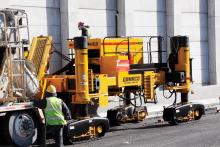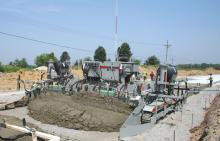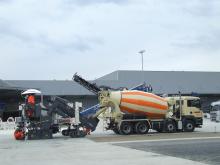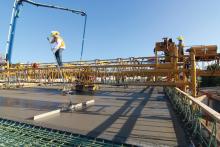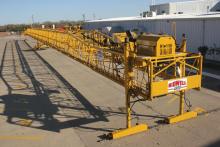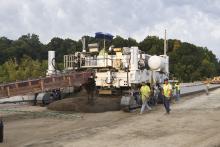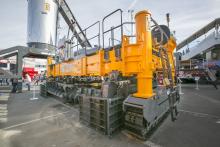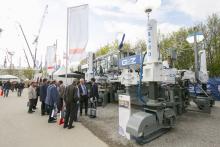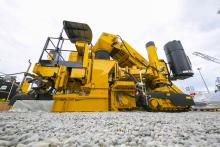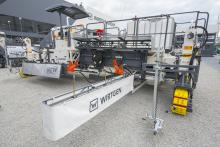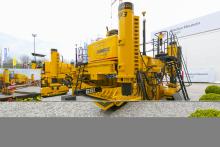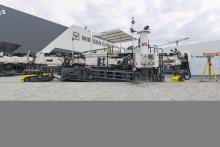The concrete road paving market continues to develop - Mike Woof reports Concrete road paving technology continues to evolve, with new equipment and techniques coming to market. Although concrete road construction has been used for many years, problems with early generation technologies affected this market segment. The first concrete roads were constructed in sections, which led to problems at joints but these were addressed many years ago with the advent of slipform paving. Concrete roads constructed in t
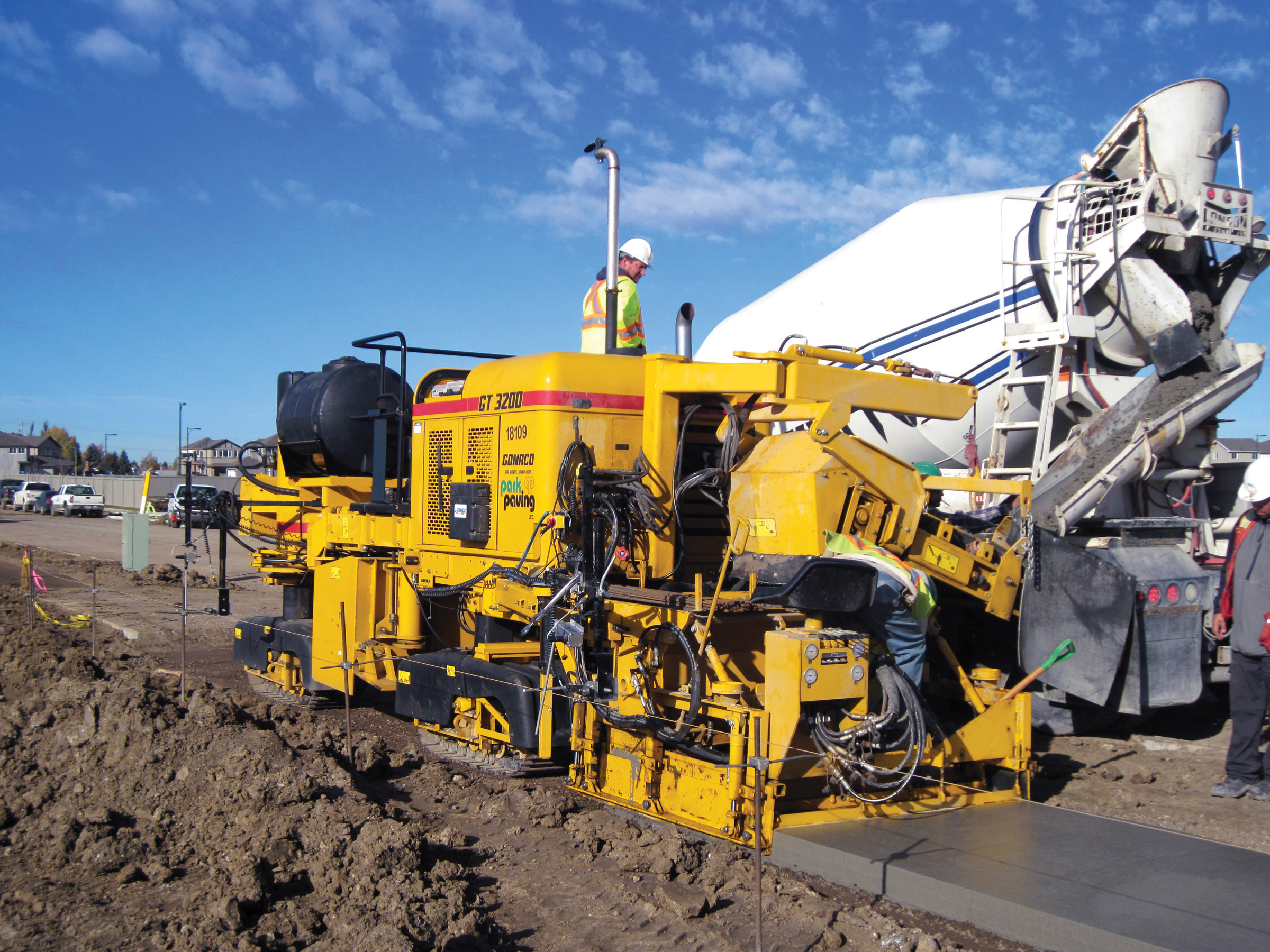
Versatility is claimed for GOMACO’s GT-3200 sidewalk machine
RSS
The first concrete roads were constructed in sections, which led to problems at joints but these were addressed many years ago with the advent of slipform paving. Concrete roads constructed in the past also suffered from noise surface generated by passing vehicles, but new technology has addressed this, as well as the issue of skid resistance in wet weather. It is worth noting that some countries such as China, which saw poor performing concrete roads built using old technology, have now recognised that using new systems address all the previous problems.
The latest research shows that surface noise on concrete roads can be tackled for instance, without major changes to construction methods. The winners of the Best Paper award at the 10th International Conference on Concrete Pavements provides a technical overview of better practices for building quieter concrete roads. Titled How to Design and Construct Quieter Concrete Pavements, the paper was co-authored by Dr Robert Rasmussen, Richard Sohaney, Gary Fick and E Thomas Cackler.
"Pavement professionals recognise the durability and long-life potential of concrete pavements, but the public also demands good ride quality and quiet pavements," said7170 International Society for Concrete Pavements president, Dr Mark Snyder. "If you can't guarantee quiet ride quality, that long life won't do you much good."
The paper can help builders achieve durability and rideability by refining conventional methods. Better practices can help contractors, engineers, and clients build quieter roads by improving methods. However one of the paper's authors, vice president and chief engineer of The5943 Transtec Group Dr Rasmussen, said some methods are easier to perfect than others.
The paper outlines fundamental characteristics of concrete texture developed under the sponsorship of the National Concrete Pavement Technology Centre (CP Tech Centre).
Focussing on control of pavement texture and other surface properties during construction allows concrete roads to be as quiet and safe as any other pavement type. With the correct procedure, concrete pavements can be constructed to be smooth, quiet, and meet durability and safety requirements.
Meanwhile in the UK, one initiative has been taken by construction firm3016 Cemex, which aims to increase the percentage of roads constructed using roller compacted concrete (RCC) techniques. Some studies suggest that in the UK, up to 90% of roads require improvements or repairs and due to the shortage of investment for infrastructure, CEMEX UK believes that using RCC could offer a long term solution with around 30% lower costs over a 50 year period.
While RCC is widely used in the US and the equipment has evolved and improved, the technique is not so common in Europe at present.
But with increasingly high crude oil costs in recent years, the price of bitumen has risen fast jumping 60% in two years. Combined with the lack of funding available for infrastructure.
CEMEX UK has decided that RCC can help keep costs down over the long term while offering offer similar levels of performance to asphalt surfaces, and over a considerable lifetime. Using a cement-based alternative to bitumen could, with the latest additives and technology, have a major impact on road design. This material is aimed at the surfacing market currently dominated by flexible asphaltic solutions.
“Around 35 per cent of the price of asphalt is directly attributable to the high cost of bitumen and it is because of this that we have developed today’s RCC, striving to get better value for our customers. Whether the binders in the mix are bitumen-based or cement-based, it is doing the same job – binding aggregates,” according to Will Fitzgerald, director Asphalt and Paving Solutions CEMEX UK.
The RCC non-slump concrete shares strength and durability attributes of traditional pavement quality concrete, but can be laid using conventional asphalt paving equipment. Once laid by the paver, transverse cracks are induced at regular intervals to allow for any potential contraction of the concrete. And one possible solution currently being explored for roads and highways is the use of RCC with a thin asphalt overlay to provide skid resistance and noise reduction.
At the same time, various manufacturers have developed new machines or upgraded existing equipment with additional features. At the upcoming688 Bauma exhibition in Munich, 218 Gomaco?will introduce its new G+ operating system as well as high versatility for the GT-3200 compact paver. The G+ Connect is GOMACO’s latest proprietary CAN-based network product allowing fast, two-way communication between all accessories and the G+ controller. The software has been developed in-house by GOMACO’s own control specialists.
GOMACO is also introducing the GT-3200 sidewalk paver with an adjustable aggregate base mold on the front and a sidewalk paving mold on the rear. This three-track paver is designed for zero-clearance sidewalk rehabilitation projects, to meet a contractor’s unique request. The front-mounted adjustable aggregate base mold spreads the base aggregate for the sidewalk. During the first pass, rock is placed on grade and an auger spreads the material, while three pan vibrators fitted to the mold start compaction. The base mold has two heavy-duty hydraulic cylinders that provide 356mm of hydraulic lift for setting the grade depth below the track line and raising the mold for the paving pass.
During the second paving pass, the sidewalk is slipformed with a minimum-clearance trailing mold. The GT-3200 sidewalk paver has a 508mm?wide by 4.3m long folding conveyor. The conveyor allows ready-mix trucks to discharge from the street instead of driving over existing curb to reach the paver. The hydraulic pivoting conveyor has also been designed to rotate 180° to load concrete into the hopper from either side of the machine and to avoid obstacles associated with zero-clearance paving. The GOMACO-proven sidewalk mold features hydraulic adjustable sideplates to form the GOMACO edge, while a trailing stainless pan provides the superior finish. The sidewalk mold can also be equipped with a bar inserter for placing transverse bars into the slab, if required by project specifications.
The GT-3200 sidewalk paver features all-track steering for manoeuvrability and can be transported without removing either the front-mounted adjustable aggregate base mold or the rear-mounted sidewalk paving mold. It also features the latest G+ control system while power comes from a C4.4T4018 Caterpillar Paving diesel rated at 67.9kW.
Guntert & Zimmerman (G&Z) continues to develop its slipformer range with the addition of the new S850SL, a multi-purpose, mid-size paver. Features to boost its versatility include swing legs and the firm’s novel telescopic ends. This machine follows on from the S600 launched first in the domestic US and then on the international market. Like its smaller sibling the new S850 shares key options including the patented AccuSteer, slew drive track control and SmartLeg swing leg systems.
The AccuSteer system uses slew drives mounted on top of the crawler track yokes and these are used to steer the tracks instead of steering cylinders. These AccuSteer drives are said to offer long working life, high accuracy and good manoeuvrability in comparison with steering cylinder systems. The AccuSteer package allows the operator to rotate the tracks independently through almost a full circle. This provides better manoeuvrability on-site and also allows rapid swing leg relocation for paving and transport, but without the need to re-pin steering cylinders.
The SmartLeg system works with AccuSteer and this combination allows the operator to adjust the swing leg angle while the machine is in use, with the machine automatically keeping the crawler track straight ahead. This feature comes in useful in urban applications in particular where there are likely to be more roadside obstacles. The option allows the contractor to manoeuvre the tracks around obstructions such as lamp posts or airport runway lights for example, without having to stop the machine to make a mechanical swing leg adjustment or re-clocking the steering transducer. This feature is said to increase productivity and allow for a more continuous slipforming operation on sites that would otherwise be problematic. The SmartLeg system also helps reduce the time needed to reconfigure the S850SL for transport and this is said to be much quicker than for conventional four track slipform pavers. By using the combination the AccuSteer and SmartLeg systems, the four swing bolsters and crawler tracks are semi-automatically walked into the outboard, transport position in around 30 minutes.
According to the company, the S850 is designed so as to minimise set-up time needed and maximise paving time when using the machine, while also delivering good smoothness capabilities, high versatility and manoeuvrability. The company claims that the S850SL is one of the narrowest profile mid-size pavers available, further increasing its versatility. When fitted with special narrow grouser pads, the machine can work next to a temporary barrier wall on a companion lane trackline as little as 300mm wide, both with and without a dowel bar inserter (DBI). The features offered with the S850SL are said to provide significant time-savings and can allow a contractor more paving time during a working shift, boosting overall productivity during the season. This versatile paver is said to suit a wide array of operations including applications on city streets, secondary roads, highway and airport paving and ramps.
The new S850SL features a patented, double telescopic tractor frame, with an access walkway, and hose hinges.
This design allows a nominal working range of 3.66-7.92m, with up to 2.13m of telescoping ability for each side.
However customers can also fit the optional bolt-in tractor frame extensions allowing paving widths of up to 12m.
When the tractor frame is equipped with the company’s patented extender system, width changes can be carried out in less than 60 minutes. To further increase its capabilities and versatility, the S850SL can be fitted with the firm’s well-proven TeleEnd system. These telescopic paving kit end sections allow additional hydraulic telescopic ability of 915mm for each end while the newer TeleEndXL can add 1.25m. Further capabilities can be added to the S850SL such as a mechanical DBI and a choice of either hydraulic or electric poker vibrator units. The S850SL’s design shares features with other machines in the range and the paving kit, front tie bar inserter and various other optional attachments are interchangeable with other G&Z paver models.
1222 Terex says that the Bid-Well 4800 bridge paver offers increased versatility and performance over the earlier version due to improvements to the fog system and crown adjuster. The new fogging system has adjustable and removable spray nozzles located on each side of the paving rollers, at the burlap drag and drag pan. These nozzles can be adjusted independently and positioned to direct the fog where it is required. The contractor can adjust the nozzles to account for wind, mix conditions or to meet specifications. In addition, the use of polyethylene tubing eliminates corrosion within the system to cut maintenance needs and maximise machine utilisation.
The 4800 has a skewable power crown adjuster that can be mounted in-line on a straight paver. It can also be positioned on the frame at the skew when contractors are paving decks with a skew angle. This option is said to simplify crown adjustments when paving at extended machine widths. The power crown adjust feature allows the operator to make quick changes while the machine is operating, as the paving carriage reaches the end of the paver.
Power for the 4800 comes from twin engines delivering 17kW each and meeting Tier 4 emissions requirements. One engine powers machine functions and movement, while the second powers the paving carriage for more consistent paving operation. The new engines are also more fuel efficient than those used on previous generation models.
Said to be highly versatile, the Terex Bid-Well 4800 paver offers an array of options to tailor it to the specific needs of certain jobsite conditions. The optional 381mm Rota-Vibe system is 30% larger than the standard unit. This provides longer machine advancements, which is particularly useful when paving streets and highways.
The paver’s twin, double-flight augers move the concrete efficiently in front of the paving carriage. Dual, 1.5m long paving rollers are said to provide a good finish to the concrete surface. The paving carriage can be equipped with the available dual drag pan arrangement, which helps contractors achieve a better concrete seal and enables the pans to drag directly to the side of the slab.
Two leg options available to paving contractors improve machine versatility. By offering zero-clearance paving, the optional swing leg design gives paving contractors an edge when paving in tight site conditions, such as overlays next to live traffic lanes and new bridge construction adjacent to the existing bridge. An available pivot leg design for the 4800 improves paving efficiency when working on cross slopes of 6-8°. This option allows the leg to be pivoted to a perpendicular position, removing stresses on the side rails and eliminating the need for extra shoring.
With its 1.2m truss frame depth, the 4800 offers standard paving widths ranging from 11-51.8m. For paving widths reaching 61m, the 4800 can be equipped with optional ultrahigh-strength steel and a 1.6764m truss frame depth at the center to prevent deflection at extended widths.
One other development of note for the concrete slipforming market was the appearance of a concrete paver on the3255 TRX Build stand at the recent 5930 Bauma China event in Shanghai. US firms such as GOMACO, Guntert & Zimmerman, 307 Power Curbers and its sister firm Power Pavers, and Terex predominate in the concrete paving market. German firm 2395 Wirtgen is the one major player in the concrete paving market segment that comes from Europe. However the Asian firm is now entering the market as well and the Singapore-owned brand is part of ST Kinetics, which produces several different types of construction equipment, including road machinery. Few details of the machine were available but according to TRX Build its HTH3400B can be used to pave slabs from 3.4-6m wide and with thicknesses of 0-350mm. Power for the 22tonne machine comes from a diesel delivering 145kW and the machine can travel between working areas at speeds of up to 1.5km/h, while it paves at speeds of up to 10m/min. The company also claims that the machine is a proven design that has been used on key construction projects in Asia.
Wirtgen continues to develop its slipformer line-up with the addition of the new, four track SP84 model. This machine offers paving widths from 3.65-7.92m and its operating weight ranges from 19-59.5tonnes, depending on the set up for the application and the width of slab being paved. Power comes from an emissions compliant diesel delivering 155kW and when folded down for transport, the machine measures 10.5m long, by 3.5m wide and 3.1m high.
At the time of writing the machine was yet to be unveiled and only these few details were available, but more information will be issued shortly. The machine is for sale worldwide, but a special slab paving mold version is also available for the US market.
Wirtgen is also introducing its latest AutoPilot Field Rover system which allows fully automatic, stringline-free concrete paving and allows jobs to be carried out more easily, quickly and economically. The system is more efficient than using conventional stringlines and is faster also, its 3D control system comprises a computer integrated into the machine and a control panel. Two GPS receivers mounted on the machine communicate with a GPS reference station on the job site. A digital terrain model is not required, as surveying and programming is carried out on the spot. The system is said to be simpler to use than conventional stringline-free 3D systems and can easily cope with minor changes on-site. The Field Rover comprises a GNSS receiver and a data collector on which the software developed by Wirtgen is installed. The software calculates the optimum course on the basis of the measured points, creating a virtual stringline and data is saved on a USB stick that is then connected to the machine. It is not necessary for the operator to enter any additional data by hand. The slipform paver then automatically moves to the starting point calculated during the survey, and moves along the defined course. If the concrete profile is to be paved up to existing roadway edges, the user can calculate the optimum virtual stringline within minutes. The firm says this system lowers paving costs and as it bases its calculations on the actual job site measurements and does not rely on construction drawings, it achieves higher paving accuracy and quality, while it is less costly than conventional 3D technology.RSS
The concrete road paving market continues to develop - Mike Woof reports
Concrete road paving technology continues to evolve, with new equipment and techniques coming to market. Although concrete road construction has been used for many years, problems with early generation technologies affected this market segment.The first concrete roads were constructed in sections, which led to problems at joints but these were addressed many years ago with the advent of slipform paving. Concrete roads constructed in the past also suffered from noise surface generated by passing vehicles, but new technology has addressed this, as well as the issue of skid resistance in wet weather. It is worth noting that some countries such as China, which saw poor performing concrete roads built using old technology, have now recognised that using new systems address all the previous problems.
The latest research shows that surface noise on concrete roads can be tackled for instance, without major changes to construction methods. The winners of the Best Paper award at the 10th International Conference on Concrete Pavements provides a technical overview of better practices for building quieter concrete roads. Titled How to Design and Construct Quieter Concrete Pavements, the paper was co-authored by Dr Robert Rasmussen, Richard Sohaney, Gary Fick and E Thomas Cackler.
"Pavement professionals recognise the durability and long-life potential of concrete pavements, but the public also demands good ride quality and quiet pavements," said
The paper can help builders achieve durability and rideability by refining conventional methods. Better practices can help contractors, engineers, and clients build quieter roads by improving methods. However one of the paper's authors, vice president and chief engineer of The
The paper outlines fundamental characteristics of concrete texture developed under the sponsorship of the National Concrete Pavement Technology Centre (CP Tech Centre).
Focussing on control of pavement texture and other surface properties during construction allows concrete roads to be as quiet and safe as any other pavement type. With the correct procedure, concrete pavements can be constructed to be smooth, quiet, and meet durability and safety requirements.
Meanwhile in the UK, one initiative has been taken by construction firm
While RCC is widely used in the US and the equipment has evolved and improved, the technique is not so common in Europe at present.
But with increasingly high crude oil costs in recent years, the price of bitumen has risen fast jumping 60% in two years. Combined with the lack of funding available for infrastructure.
CEMEX UK has decided that RCC can help keep costs down over the long term while offering offer similar levels of performance to asphalt surfaces, and over a considerable lifetime. Using a cement-based alternative to bitumen could, with the latest additives and technology, have a major impact on road design. This material is aimed at the surfacing market currently dominated by flexible asphaltic solutions.
“Around 35 per cent of the price of asphalt is directly attributable to the high cost of bitumen and it is because of this that we have developed today’s RCC, striving to get better value for our customers. Whether the binders in the mix are bitumen-based or cement-based, it is doing the same job – binding aggregates,” according to Will Fitzgerald, director Asphalt and Paving Solutions CEMEX UK.
The RCC non-slump concrete shares strength and durability attributes of traditional pavement quality concrete, but can be laid using conventional asphalt paving equipment. Once laid by the paver, transverse cracks are induced at regular intervals to allow for any potential contraction of the concrete. And one possible solution currently being explored for roads and highways is the use of RCC with a thin asphalt overlay to provide skid resistance and noise reduction.
At the same time, various manufacturers have developed new machines or upgraded existing equipment with additional features. At the upcoming
GOMACO is also introducing the GT-3200 sidewalk paver with an adjustable aggregate base mold on the front and a sidewalk paving mold on the rear. This three-track paver is designed for zero-clearance sidewalk rehabilitation projects, to meet a contractor’s unique request. The front-mounted adjustable aggregate base mold spreads the base aggregate for the sidewalk. During the first pass, rock is placed on grade and an auger spreads the material, while three pan vibrators fitted to the mold start compaction. The base mold has two heavy-duty hydraulic cylinders that provide 356mm of hydraulic lift for setting the grade depth below the track line and raising the mold for the paving pass.
During the second paving pass, the sidewalk is slipformed with a minimum-clearance trailing mold. The GT-3200 sidewalk paver has a 508mm?wide by 4.3m long folding conveyor. The conveyor allows ready-mix trucks to discharge from the street instead of driving over existing curb to reach the paver. The hydraulic pivoting conveyor has also been designed to rotate 180° to load concrete into the hopper from either side of the machine and to avoid obstacles associated with zero-clearance paving. The GOMACO-proven sidewalk mold features hydraulic adjustable sideplates to form the GOMACO edge, while a trailing stainless pan provides the superior finish. The sidewalk mold can also be equipped with a bar inserter for placing transverse bars into the slab, if required by project specifications.
The GT-3200 sidewalk paver features all-track steering for manoeuvrability and can be transported without removing either the front-mounted adjustable aggregate base mold or the rear-mounted sidewalk paving mold. It also features the latest G+ control system while power comes from a C4.4T
Guntert & Zimmerman (G&Z) continues to develop its slipformer range with the addition of the new S850SL, a multi-purpose, mid-size paver. Features to boost its versatility include swing legs and the firm’s novel telescopic ends. This machine follows on from the S600 launched first in the domestic US and then on the international market. Like its smaller sibling the new S850 shares key options including the patented AccuSteer, slew drive track control and SmartLeg swing leg systems.
The AccuSteer system uses slew drives mounted on top of the crawler track yokes and these are used to steer the tracks instead of steering cylinders. These AccuSteer drives are said to offer long working life, high accuracy and good manoeuvrability in comparison with steering cylinder systems. The AccuSteer package allows the operator to rotate the tracks independently through almost a full circle. This provides better manoeuvrability on-site and also allows rapid swing leg relocation for paving and transport, but without the need to re-pin steering cylinders.
The SmartLeg system works with AccuSteer and this combination allows the operator to adjust the swing leg angle while the machine is in use, with the machine automatically keeping the crawler track straight ahead. This feature comes in useful in urban applications in particular where there are likely to be more roadside obstacles. The option allows the contractor to manoeuvre the tracks around obstructions such as lamp posts or airport runway lights for example, without having to stop the machine to make a mechanical swing leg adjustment or re-clocking the steering transducer. This feature is said to increase productivity and allow for a more continuous slipforming operation on sites that would otherwise be problematic. The SmartLeg system also helps reduce the time needed to reconfigure the S850SL for transport and this is said to be much quicker than for conventional four track slipform pavers. By using the combination the AccuSteer and SmartLeg systems, the four swing bolsters and crawler tracks are semi-automatically walked into the outboard, transport position in around 30 minutes.
According to the company, the S850 is designed so as to minimise set-up time needed and maximise paving time when using the machine, while also delivering good smoothness capabilities, high versatility and manoeuvrability. The company claims that the S850SL is one of the narrowest profile mid-size pavers available, further increasing its versatility. When fitted with special narrow grouser pads, the machine can work next to a temporary barrier wall on a companion lane trackline as little as 300mm wide, both with and without a dowel bar inserter (DBI). The features offered with the S850SL are said to provide significant time-savings and can allow a contractor more paving time during a working shift, boosting overall productivity during the season. This versatile paver is said to suit a wide array of operations including applications on city streets, secondary roads, highway and airport paving and ramps.
The new S850SL features a patented, double telescopic tractor frame, with an access walkway, and hose hinges.
This design allows a nominal working range of 3.66-7.92m, with up to 2.13m of telescoping ability for each side.
However customers can also fit the optional bolt-in tractor frame extensions allowing paving widths of up to 12m.
When the tractor frame is equipped with the company’s patented extender system, width changes can be carried out in less than 60 minutes. To further increase its capabilities and versatility, the S850SL can be fitted with the firm’s well-proven TeleEnd system. These telescopic paving kit end sections allow additional hydraulic telescopic ability of 915mm for each end while the newer TeleEndXL can add 1.25m. Further capabilities can be added to the S850SL such as a mechanical DBI and a choice of either hydraulic or electric poker vibrator units. The S850SL’s design shares features with other machines in the range and the paving kit, front tie bar inserter and various other optional attachments are interchangeable with other G&Z paver models.
The 4800 has a skewable power crown adjuster that can be mounted in-line on a straight paver. It can also be positioned on the frame at the skew when contractors are paving decks with a skew angle. This option is said to simplify crown adjustments when paving at extended machine widths. The power crown adjust feature allows the operator to make quick changes while the machine is operating, as the paving carriage reaches the end of the paver.
Power for the 4800 comes from twin engines delivering 17kW each and meeting Tier 4 emissions requirements. One engine powers machine functions and movement, while the second powers the paving carriage for more consistent paving operation. The new engines are also more fuel efficient than those used on previous generation models.
Said to be highly versatile, the Terex Bid-Well 4800 paver offers an array of options to tailor it to the specific needs of certain jobsite conditions. The optional 381mm Rota-Vibe system is 30% larger than the standard unit. This provides longer machine advancements, which is particularly useful when paving streets and highways.
The paver’s twin, double-flight augers move the concrete efficiently in front of the paving carriage. Dual, 1.5m long paving rollers are said to provide a good finish to the concrete surface. The paving carriage can be equipped with the available dual drag pan arrangement, which helps contractors achieve a better concrete seal and enables the pans to drag directly to the side of the slab.
Two leg options available to paving contractors improve machine versatility. By offering zero-clearance paving, the optional swing leg design gives paving contractors an edge when paving in tight site conditions, such as overlays next to live traffic lanes and new bridge construction adjacent to the existing bridge. An available pivot leg design for the 4800 improves paving efficiency when working on cross slopes of 6-8°. This option allows the leg to be pivoted to a perpendicular position, removing stresses on the side rails and eliminating the need for extra shoring.
With its 1.2m truss frame depth, the 4800 offers standard paving widths ranging from 11-51.8m. For paving widths reaching 61m, the 4800 can be equipped with optional ultrahigh-strength steel and a 1.6764m truss frame depth at the center to prevent deflection at extended widths.
One other development of note for the concrete slipforming market was the appearance of a concrete paver on the
Wirtgen continues to develop its slipformer line-up with the addition of the new, four track SP84 model. This machine offers paving widths from 3.65-7.92m and its operating weight ranges from 19-59.5tonnes, depending on the set up for the application and the width of slab being paved. Power comes from an emissions compliant diesel delivering 155kW and when folded down for transport, the machine measures 10.5m long, by 3.5m wide and 3.1m high.
At the time of writing the machine was yet to be unveiled and only these few details were available, but more information will be issued shortly. The machine is for sale worldwide, but a special slab paving mold version is also available for the US market.
Wirtgen is also introducing its latest AutoPilot Field Rover system which allows fully automatic, stringline-free concrete paving and allows jobs to be carried out more easily, quickly and economically. The system is more efficient than using conventional stringlines and is faster also, its 3D control system comprises a computer integrated into the machine and a control panel. Two GPS receivers mounted on the machine communicate with a GPS reference station on the job site. A digital terrain model is not required, as surveying and programming is carried out on the spot. The system is said to be simpler to use than conventional stringline-free 3D systems and can easily cope with minor changes on-site. The Field Rover comprises a GNSS receiver and a data collector on which the software developed by Wirtgen is installed. The software calculates the optimum course on the basis of the measured points, creating a virtual stringline and data is saved on a USB stick that is then connected to the machine. It is not necessary for the operator to enter any additional data by hand. The slipform paver then automatically moves to the starting point calculated during the survey, and moves along the defined course. If the concrete profile is to be paved up to existing roadway edges, the user can calculate the optimum virtual stringline within minutes. The firm says this system lowers paving costs and as it bases its calculations on the actual job site measurements and does not rely on construction drawings, it achieves higher paving accuracy and quality, while it is less costly than conventional 3D technology.RSS

